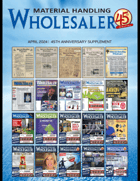 Garry Bartecki
Garry Bartecki Does your dealership have a performance gap?
As you know, I love to review business and industry data daily. I probably read 100 emails daily and receive various industry and financial magazines monthly.
I find it notable how the content today compares to what I read five years ago. Even with my financial mind, I see some of this new data requires a new level of understanding, especially if a dealer wants to keep their current competitive edge.
Companies must adapt to new costs and procedures to stay competitive today and into the future to improve productivity and efficiency. This keeps the company competitive even though competitors are going through similar exercises.
Management will need to decide what changes they can afford and assess their ability to have the tech personnel in-house to monitor the installation of the new technology. But even more critical will be to determine the expected ROI on this investment and how to measure it.
Dealers that take a long-term approach to their business will most likely do what needs to be done to protect their market and customer relationships, as well as have the ability to attract new customers.
However, dealers may decide not to incur the costs of new technology because the company’s size would not allow them to absorb the expenses, which would negatively impact profits and cash flow. Dealers may also plan to sell the business within the next five years and do not believe that the tech expense will provide adequate returns over the next five years. This would probably reduce the company’s value because of the tech cost incurred.
For the dealers who, for whatever reason, decide not to upgrade their technology, there is a problem that could prove to be very costly, and it has to do with their performance gap and the speed with which it will increase over the next five years. In other words, your company’s value could be worth X today but be worth much less five years from now because the performance gap has increased over the five years to a point where your company’s worth declined dramatically compared to what it is worth today.
A performance gap is defined as the difference between the decided performance level and the company’s actual performance. I suggest that this gap should also be calculated against your competitors because a company could meet its internal goals but still fall behind competitors who are taking steps to improve productivity and efficiency to the point where they are more price-competitive without missing profit and cash flow requirements.
In one of the emails I read, it was suggested that those planning to sell in five years should sell now when the performance gap is at a level where a buyer can upgrade the technology with a reasonable ROI. Selling now may even be more beneficial because of the potential new customers anticipated because of the new USA policies wanting to bring back manufacturing.
What makes this so different now is the speed at which changes occur. This sudden change in activity could very quickly affect a company’s value over five years. Those that adapted get better results, and those that didn’t adopt have the exact numbers they had five years earlier. It appears this would cause lower values for companies that did not embrace it.
Let’s review what can cause a performance gap.
- Technological Advancements- Invest or fall behind.
- Talent and Skill Development – Improve or fall behind.
- Process Optimization – Better efficiency and resource utilization or fall behind.
- Innovation – Stay ahead of the market or fall behind.
- Customer Focus – Meet customer needs or fall behind.
- Leadership and Strategy – You either have it or not.
Addressing these factors proactively can close a performance gap and improve long-term success. BUT THEY REQUIRE CAPITAL AND EFFECTIVE LEADERSHIP.
This capital requirement could be substantial for many dealers. Assuming you have a borrowing capacity, it may require a capital contribution from the shareholders or a new bank loan. If I were facing a widening performance gap and there was no funding available, I would determine the company’s market value and review the dealer agreement to see your options.
When considering the options, the early sale is probably the safest option. Making significant investments now would not be high on my list. I would take my money now at these lower tax rates or work out an installment sale so you can keep working if that is what you want to do.
Those dealers in for the long-term should look into getting some outside help to create a plan of action, determine if there is adequate tech horsepower in-house, oversee negotiations for the purchase of new technology, manage the installation of the latest tech, estimate an ROI on the investment, train the staff how to use the new tech, and track company performance against industry metrics and the ROI estimate. There are people out there who provide these types of services.
Do you have a performance gap? Are you planning on selling out in the next five years? Are you able to work through the performance gap factors listed above? How are you performing against MHEDA stats?
If you have concerns, get some help.
About the Columnist:
Garry Bartecki is a CPA MBA with GB Financial Services LLC and a Wholesaler columnist since August 1993. E-mail editorial@mhwmag.com to contact Garry.









